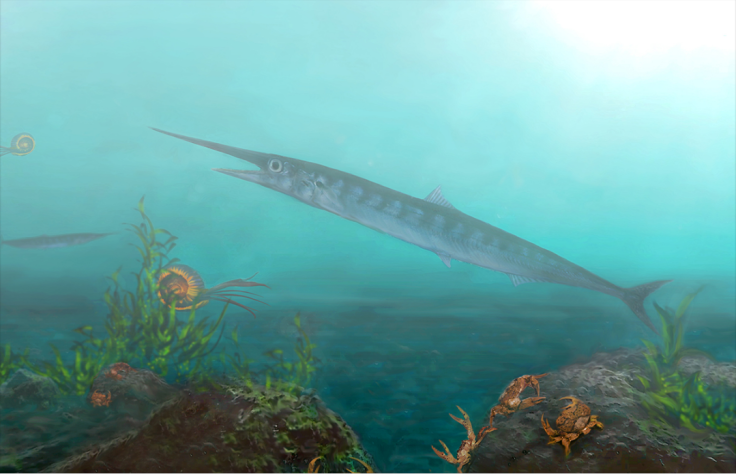90-million-year-old lizard fish fossil found by a young boy in South America is first of its kind
The perfectly preserved fossil of the ancient sea creature was dated back to the Cretaceous period.

An incredibly rare, 90-million-year-old fossil of an ancient sea creature was found in Colombia by a young tourist. The discovery was made by a 10-year-old-boy named Rio Santiago Dolmetsch, a palaeontology enthusiast, while he was visiting the Monastery of La Candelaria in Colombia in 2015.
The fossil, which has been named Candelarhynchus padillai, was identified as belonging to a rare species of "lizard fish" and is the first of its kind ever to be found in Columbia and tropical South America.
"A kid was walking into the monastery during a tour when he noticed the shape of a fish in a flagstones on the ground," Javier Luque, a PhD candidate at the University of Alberta and co-author on the new study, said in a statement. "He took a photo and, a few days later, showed it to staff at the Centro de Investigaciones Paleontologicas, a local museum with whom we collaborate to protect and study fossil findings from the region."
The fossil provides important insight into the biodiversity of the area in ancient times, adding to our knowledge of animal life during the Cretaceous period.
"The tropics worldwide are hotspots of diversity," explains Luque. "Interestingly, we know a great deal about modern biodiversity in these areas, but the fossil record is poorly understood in comparison. This adds another piece to that puzzle."
According to Oksana Vernygora, a PhD student in the department of biological sciences at the University of Albnerta and lead author of the study, the prehistoric sea creature, has no modern relatives. The ancient fish swam about in the Earth's oceans during the Cretaceous period, which lasted from 66 million years to 145 million years ago and was a time when dinosaurs reigned supreme over our planet.
"It is rare to find such a complete fossil of a fish from this moment in the Cretaceous period. Deepwater fish are difficult to recover, as well as those from environments with fast flowing waters," said Vernygora. "But what surprises me the most is that, after 15 years of being on a walkway, it was still intact. It's amazing."
http://www.tandfonline.com/doi/full/10.1080/14772019.2017.1391884Felicitaciones al CIP por su nueva...
Posted by Centro de Investigaciones Paleontológicas (C.I.P.) Villa de Leyva on Wednesday, November 15, 2017
The ancient sea creature was slim, with a long jaw and fine teeth and measured around 16 inches long, the National Geographic reported. The lizard fish reportedly preyed on small organisms such as crustaceans, larvae, and mollusks.
The fossil is a significant piece of evidence that reveals the historical evolution of underwater creatures brought upon by climatic and environmental changes over the years.
"Often we think, we have fish now, we had fish then, we'll likely have fish in the future. But the importance of fish is just that," she said. "We can see how fish have changed as their environments have changed throughout history. Studying fish diversity gives us amazing predicting power for the future--especially as we start to see the effects of climate change."
The findings of the new research have been published in the Journal of Systematic Palaeontology.






















